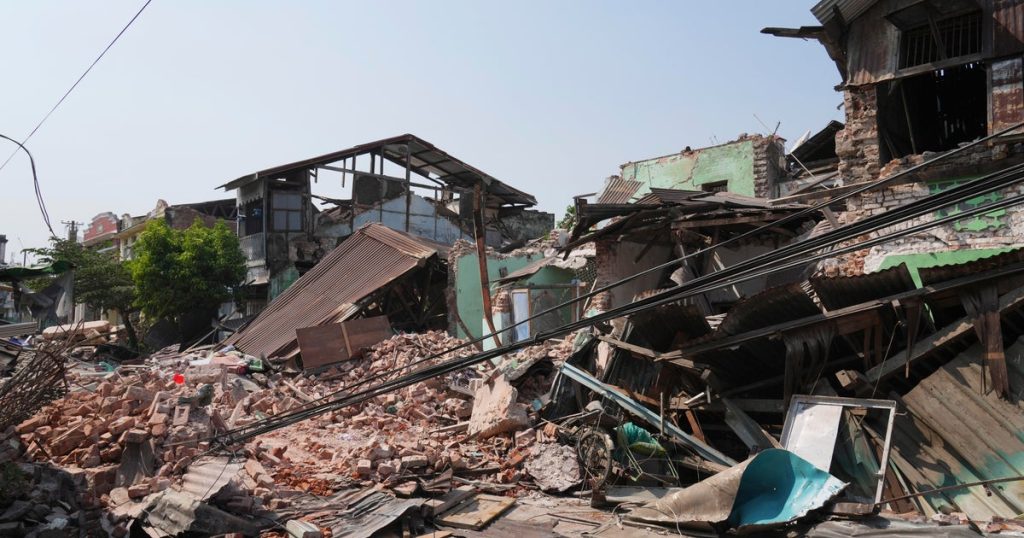A devastating earthquake measuring 7.7 on the Richter scale struck Myanmar and Thailand on Friday, resulting in significant loss of life and extensive destruction across both countries. As of Sunday night, the death toll had risen to over 1,700 people in Myanmar and the greater Bangkok area, marking one of the most catastrophic natural disasters in the region’s recent history. With thousands injured and many missing, officials are grappling with the aftermath as international aid begins to flow into the hardest-hit areas.
| Article Subheadings |
|---|
| 1) Impact of the Earthquake in Myanmar |
| 2) Emergency Response and Aid Efforts |
| 3) Specific Areas Affected |
| 4) International Support Mobilized |
| 5) Long-term Recovery Plans |
Impact of the Earthquake in Myanmar
The 7.7 magnitude earthquake wreaked havoc across Myanmar, confirming the deaths of over 1,700 individuals by Sunday. The quake’s epicenter was located near Mandalay, Myanmar’s second-largest city, which has a population of about 1.5 million. Many structures, including homes and critical infrastructure like the historic Ava Bridge and Mandalay University, have been severely damaged or completely destroyed. The exact extent of injury and fatalities is still being assessed, with reports indicating that 3,408 individuals have been injured and approximately 139 remain unaccounted for, further exacerbating the crisis.
Emergency Response and Aid Efforts
In the wake of the disaster, officials have mobilized various emergency response efforts to locate survivors trapped beneath rubble and provide medical care to the injured. Rescue teams are facing significant challenges due to compromised telecommunications and infrastructure, which complicate the coordination of relief operations. As assessments of the damage continue, Myanmar has extended requests for emergency assistance to the international community, expecting urgent supplies of food, medicine, and shelter for those affected in the coming weeks.
Specific Areas Affected
Beyond Mandalay, significant destruction has been reported in regions such as Sagaing, Naypyidaw, Magway, and Bago. The earthquake has left many areas without power and disrupted transportation routes, causing delays in getting essential supplies to those in need. Reports indicate that the greatest damage extends along a wide swath of middle Myanmar, stressing the importance of thorough assessments to gauge the full impact of the disaster. Areas such as Naypyidaw and the suburbs of Mandalay are experiencing extensive infrastructural damage, leaving communities in dire conditions.
International Support Mobilized
In response to the humanitarian crisis, numerous countries have offered support and assistance to Myanmar. Among those contributing aid are India, China, Singapore, and Thailand, with each country dispatching teams and resources. Notably, the British Foreign Office has pledged £10 million (approximately $12 million) focusing on humanitarian assistance in the most affected areas. International agencies such as the Red Cross have also stepped up by appealing for over $100 million in aid to support survivors and provide immediate relief. The funds will be used to assist up to 100,000 people over the next two years, focusing on food, water, and medical assistance.
Long-term Recovery Plans
As the immediate response to the earthquake unfolds, planning for long-term recovery is becoming a priority for both local and international bodies. The emphasis is on rebuilding infrastructure, restoring public services, and preparing the areas to manage future disasters more effectively. With nearly 3 tons of emergency medical supplies dispatched by the World Health Organization, the focus is shifting towards establishing sustainable living conditions for displaced individuals. Evolving strategies will continue to be developed based on the outcomes of ongoing assessments.
| No. | Key Points |
|---|---|
| 1 | More than 1,700 fatalities confirmed in Myanmar due to the earthquake. |
| 2 | Numerous aid agencies and countries responding with humanitarian assistance. |
| 3 | Critical infrastructure destroyed including major bridges and universities. |
| 4 | Reports of over 3,400 individuals injured and hundreds missing. |
| 5 | International efforts underway for long-term recovery and support. |
Summary
The earthquake in Myanmar and Thailand has resulted in a tragic loss of life and widespread devastation. The response from both local authorities and the international community highlights the urgent need for humanitarian aid and the provision of essential services to those affected. As recovery efforts continue, the emphasis will be on rebuilding and preparing for future disasters.
Frequently Asked Questions
Question: How did the earthquake affect infrastructure?
The earthquake caused significant destruction to critical infrastructure, including bridges, universities, and residential buildings, especially in Mandalay and its surrounding areas.
Question: What assistance is being provided to the affected regions?
Various countries and international agencies have pledged financial and material aid, focusing on immediate relief efforts including food, shelter, and medical assistance.
Question: What are the long-term strategies being implemented for recovery?
Long-term recovery strategies include infrastructure rebuilding, restoration of public services, and strengthening community resilience to manage future disasters more effectively.
